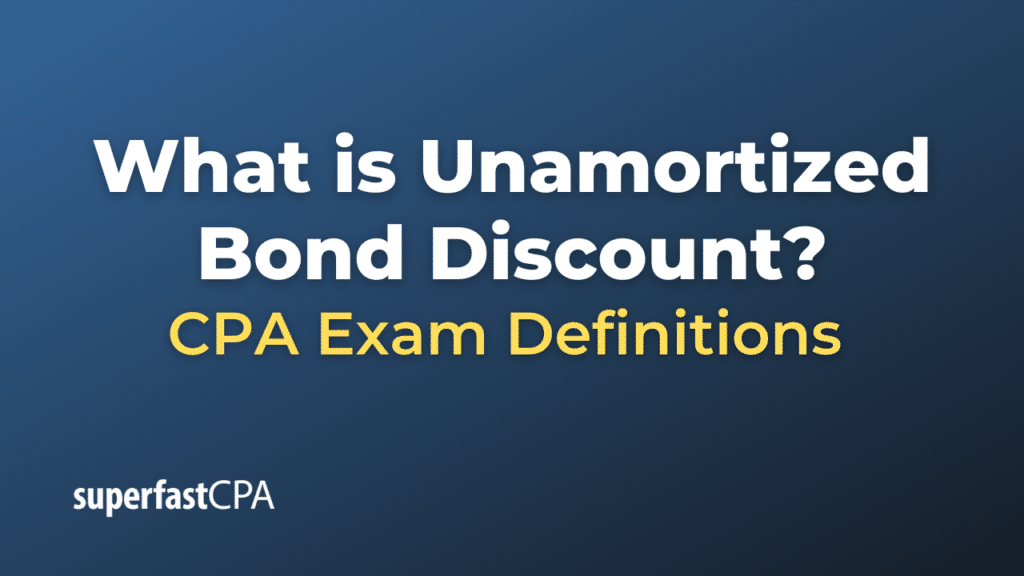Unamortized Bond Discount
“Unamortized Bond Discount” refers to the portion of a bond discount that has not yet been amortized (or expensed) over the life of the bond. To understand this concept fully, it’s essential to start by grasping the basics of bond issuance at a discount.
Bond Issuance at a Discount:
When a bond is issued for less than its face (or par) value, the difference between the face value and the issuance price is termed as the bond discount. The discount arises typically when the stated interest rate on the bond is lower than the prevailing market interest rate, making the bond less attractive to potential buyers unless it’s offered at a lower price.
The bond discount is not treated as an expense all at once. Instead, it’s amortized over the life of the bond. As time progresses and the bond discount is gradually expensed, the unamortized portion decreases.
Unamortized Bond Discount:
This represents the cumulative portion of a bond discount that has yet to be amortized. As the bond approaches its maturity date, the unamortized bond discount will reduce to zero.
Accounting Treatment:
The bond discount is treated as an indirect reduction to the carrying value of the bond on the balance sheet. As the discount is amortized, it increases the carrying amount of the bond. The amortization of the bond discount also results in additional interest expense on the income statement.
For example, if a company issues a 5-year bond with a face value of $1,000 at an issuance price of $950, it has an initial bond discount of $50. Over the five years, this $50 discount will be amortized as additional interest expense. If, after the first year, $10 of the discount has been amortized, the unamortized bond discount would be $40 ($50 initial discount – $10 amortized).
In essence, the unamortized bond discount serves two purposes:
- It reduces the carrying value of the bond liability on the balance sheet until the bond reaches its face value at maturity.
- It increases the effective interest expense recorded in the income statement over the life of the bond.
Example of Unamortized Bond Discount
Let’s dive into a more detailed example regarding the unamortized bond discount.
Example: Bond Issued at a Discount
Suppose ABC Corporation issues a 3-year, $1,000 face value bond with a stated annual interest rate of 5%. However, the prevailing market rate is 6%. Because the bond’s interest rate is less attractive than the market rate, investors would be unwilling to pay the full face value for the bond. As a result, ABC Corporation sells the bond for $970. The bond discount is the difference between the face value and the issuance price, which in this case is $30 ($1,000 – $970).
To simplify the amortization, we’ll use the straight-line method over the bond’s 3-year life, although in real-world scenarios, the effective interest method is more commonly used.
Yearly Amortization Calculation:
Bond Discount ÷ Bond Life = Annual Amortization Amount
$30 ÷ 3 years = $10 per year
Yearly Amortization of Bond Discount:
| Year | Beginning Unamortized Discount | Amortization for the Year | Ending Unamortized Discount | Carrying Value of Bond |
|---|---|---|---|---|
| 1 | $30 | $10 | $20 | $980 ($1,000 – $20) |
| 2 | $20 | $10 | $10 | $990 ($1,000 – $10) |
| 3 | $10 | $10 | $0 | $1,000 |
For Year 1:
- Debit: Cash: $970 (Amount received)
- Debit: Discount on Bonds Payable: $30 (Difference between face value and cash received)
- Credit: Bonds Payable: $1,000 (Face value of the bond)
During each year:
- Debit: Interest Expense: $60 (5% of $1,000 face value + $10 straight-line amortization of the discount)
- Credit: Cash: $50 (5% of $1,000 face value)
- Credit: Discount on Bonds Payable: $10 (Amortization of the discount)
By the end of Year 3, the entire bond discount has been amortized, and the bond’s carrying value on the balance sheet equals its face value.













